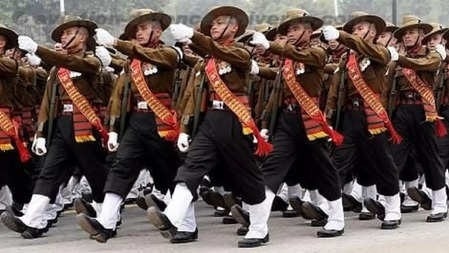Nepal’s External Affairs Minister Arzu Rana Deuba’s five-day visit to India has reignited the issue of Gorkha recruitment. The Indian Army continues to face a severe shortage of Nepali Gorkhas in the traditional Gorkha battalions. Bilateral talks between the foreign ministers of India and Nepal in Delhi have raised hopes of resolving the stalled Gorkha recruitment.
There has not been a single Nepali Gorkha recruited into the Indian Army since 2020, when recruitment rallies were halted due to Covid-19. After recruitment drives resumed post-Covid, the Indian government announced the Agnipath scheme in June 2022.
advertisement
Nepal did not agree to the short-term service for Gorkhas in the Indian Army under the Agnipath scheme, leading to a deadlock in recruitment. This has created a significant shortage of Gorkha soldiers in the traditional ethnic Gorkha battalions of the Indian Army.
According to official sources, the Indian Army is still facing a shortfall of over 15,000 soldiers in its seven Gorkha Regiments, which comprise 39 Battalions with a total strength of around 32,000 Gorkha soldiers.
Attempts have been made by the Indian side to convince Nepal to participate in recruitment under the Agnipath scheme, but the roadblock remains. Gorkha recruitment into the Indian Army from Nepal has been completely stopped for the last four years.
The bilateral meeting between Nepal’s Foreign Minister Arzu Rana Deuba and India’s External Affairs Minister S Jaishankar has once again brought this issue to the forefront. As the Foreign Minister of Nepal is on a five-day visit to India, a breakthrough over Gorkha recruitment into the Indian Army is awaited.
200-YEAR-OLD HISTORY
The history of the Gorkha Regiment in India is 200 years old. After independence, the Gorkha battalions played a crucial role in all the wars fought by India. Particularly, the Gorkhas from Nepal are considered the most brave and fearless, which is why they have always held a special place in the Indian Army.
However, the lack of recruitment due to the Agnipath scheme has not only affected the Indian Army but also deepened the crisis within the Gorkha battalions, which are known by their name.
GORKHAS IN THE ARMIES OF THREE COUNTRIES
From Galwan in Ladakh to Jammu and Kashmir, the Gorkha battalions have a strong presence.
The Gorkha battalion is the only regiment in the world that is an integral part of the armies of three countries. Despite the shortage, the majority of Gorkha soldiers still serve in the Indian Army, followed by the British Army and the Nepalese Army.
This regiment in the Indian Army includes both Nepali Gorkhas and Indian Gorkhas. However, a challenge for the Indian Army is the significant decline in the number of Nepali Gorkhas over the past three years.
CHALLENGES FACED BY THE INDIAN ARMY
According to Indian Army officials, before independence, about 90 per cent of the soldiers in the Gorkha Regiment were from Nepal, and 10 per cent were Indian Gorkhas.
Over time, this ratio was adjusted to 80:20 and later to 60:40, meaning 60 per cent Nepali domicile Gorkhas and 40 per cent Indian domicile Gorkhas.
In recent years, the Indian Army has faced difficulties in recruiting Nepali Gorkhas, and there has also been a decline in the recruitment of Indian domicile Gorkhas.
In response, the Indian Army has recently started recruiting youth from Garhwal and Kumaon into this regiment. This is the first time that non-Gorkha youth from other regions have been included in the Gorkha Regiment.
10 REGIMENTS AT THE TIME OF INDEPENDENCE
At the time of independence, there were a total of 10 Gorkha regiments established by the British. After independence, when the army was divided, the British retained four regiments (2, 6, 7, and 10), and India received six regiments (1, 3, 4, 5, 8, and 9).
After 1947, the Indian Army established another Gorkha regiment, known as the 11th Gorkha Regiment. One of the four regiments that went to the British was later disbanded.
Must Watch
